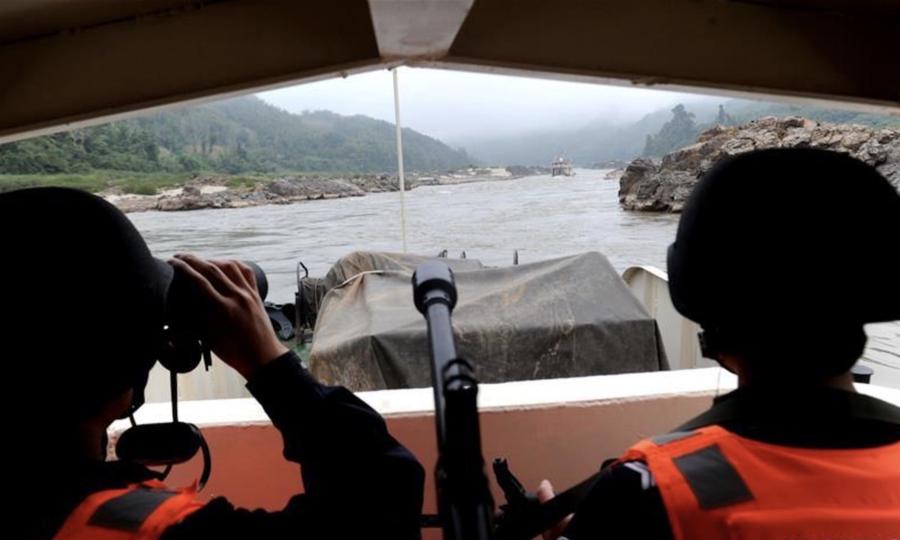
Water conflict risk rising on the Mekong river
China’s newly consolidated ability to stop the river’s flow to SE Asia points to an emerging new regional flashpoint
The Mekong River, a waterway that originates in China and snakes through five Southeast Asian countries, is emerging as a new security flashpoint, similar in dynamic to escalating conflicts in the South China Sea.
China has built 11 dams and has plans for another eight along its upper stretch of the river, which begins in the Tibetan Plateau, stretches through much of mainland Southeast Asia, and ends in Vietnam’s rice-producing Mekong Delta.

Apart from the environmental consequences, there is an emerging strategic component to the dams, one that has reduced Southeast Asian nations’ leverage vis-à-vis China and its wider designs for the neighboring region.
China now has the power to completely stop the flow of water to downstream nations, a pressure point that could be used to devastate their agricultural economies and create food scarcity in the event of a conflict.
Beijing could also leverage the threat to extract greater deference from Southeast Asian states or punish those that oppose Beijing’s expansionist policies, including in the South China Sea as well as its Belt and Road Initiative (BRI) schemes in the region, analysts say.
Speaking on August 1 after a Lower Mekong Initiative Ministerial meeting in Bangkok, US Secretary of State Mike Pompeo noted: “We see a spree of upstream dam building which concentrates control over downstream flows.”
Scholars, meanwhile, have spoken of the Mekong River as the “next South China Sea” in terms of an emerging flashpoint.
In 2017, Eugene Chow, an independent analyst, described China’s dams as weapons “hidden in plain sight” that “allow it to hold a quarter of the world’s population hostage without firing a single shot.”
Downstream nations’ vulnerability to China’s dams is plain to see. In 2016, Southeast Asian governments pleaded with China to release more water from its upstream dams to help alleviate a harsh drought. Beijing obliged, but analysts noted the incident underscored just how much control China has recently developed over the waterway.
“Next time, China could well demand something in return, and a desperately thirsty country may not be able to refuse. China could, in short, use its dams to weaponize water,” Brahma Chellaney, a professor of Strategic Studies at the New Delhi-based Center for Policy Research, recently wrote.

“As droughts become more frequent and severe, China’s dam network gives it increasing leverage over downriver countries,” he added.
A similar situation emerged earlier this year. When Chinese authorities opened the Jinghong Dam’s gates for maintenance purposes, it caused floods downstream in Laos and Thailand that reports said destroyed crops and fisheries.
After the repair work was finished, Chinese authorities refilled the emptied dam causing water levels to drop downstream. Because the repair work took place as a drought hit Southeast Asia in July, the river fell to its lowest levels in decades, causing several Southeast Asian nations to appeal again to Beijing to release more water downstream.
At the time, China’s embassy in Thailand claimed Beijing’s care over the river “embodies a natural bond of mutual support.” “China pays great attention to the concerns and requirements of downstream countries,” said Yang Yang, an embassy spokesperson.
Beijing claims allegations of weaponizing the river are bogus and unfairly depict China as a regional bully.

But potential threats and real leverage determine foreign policy. “Now China is completely in control of the water,” Premrudee Deoruong of Laos Dam Investment Monitor, an environmental group, said about the Mekong in July.
“From now on, the concern is that the water will be controlled by the dam builders.”
Indeed, if China’s assertiveness in the South China Sea is viewed as a form of “gunboat diplomacy”, then its actions on the Mekong are a subtler but potentially more potent “stopcock diplomacy.”
As the Mekong’s most downstream nation, Vietnam – which also happens to be the most vocal opponent of Beijing’s moves in the South China Sea – would be the most impacted if China ever moved to stop the river’s flow.
An article published in August in the National Defense Journal, a Vietnamese Defense Ministry-run publication, acknowledged as much, though couched in its usual prosaic language.
“Vietnam is a country prone to natural disasters, so the potential for crop failure is very high. If this happens, even in peacetime conditions, the country will face many difficulties; if it happens in wartime, the difficulty will be multiplied,” it stated. “Therefore, ensuring national food security is a strategic issue.”

Beijing could, for instance, threaten to cut off Vietnam’s Mekong River derived water supplies unless Hanoi yields to its demands in the South China Sea.
A similar threat could allow Beijing to have its way in Laos, a country highly reliant on its own hydropower dams, many of which have been built with Chinese loans and by Chinese construction firms.
China is also building dams in Laos and Cambodia (and has a major one halted in Myanmar), which has been a useful way of finding new revenue for China’s major construction firms that have seen growth and commercial opportunities slacken at home.
In the early 2000s, the Mekong River Commission – made up of Laos, Thailand, Cambodia and Vietnam – predicted its members’ economies would benefit economically to the tune of $30 billion from dam building along their respective portions of the Mekong.
But, as the New York Times noted this week, that figure has since been revised down drastically to a $7 billion loss.
Power and mining exports account for about a third of Laos’ gross domestic product (GDP). If China was to threaten to shut off water flows to Laos, it would not take long for the stoppage to destabilize the landlocked nation’s entire economy.

To be sure, Beijing cannot selectively turn off the water supply for, say, Vietnam alone, as cutting off the flow of the water downstream would also affect Laos, Myanmar, Thailand and Cambodia.
Any such move would be made as a collective punishment against all of mainland Southeast Asia, rather than in response to the actions of just one nation. Still, the threat weakens Southeast Asian unity, analysts say.
Is Bangkok more likely to support Hanoi’s claims in the South China Sea, for instance, if Thailand could be affected by a punitive response on the Mekong by Beijing? Thailand’s tepid approach to the sea disputes as this year’s rotational chairman of the Association of Southeast Asian Nations (ASEAN) has shown its national interests are in play while steering the wider bloc.
But if there is to be a “water war” in Southeast Asia, conflict on the Mekong would be far more complex than the ongoing disputes in the South China Sea. Those disputes boil down to which features in the maritime area belong to which nation. The sea disputes could be settled by international law, if Beijing agreed.
For the Mekong, sovereignty over the waterway is not in dispute. The section of the Mekong that lies within Chinese territory is indisputably under Chinese sovereignty. How Beijing manages its stretch of the river is its sole responsibility, and cannot be determined or influenced by the international community or other Mekong nations.
It is thus not a question of national sovereignty but rather common ownership – a far less clear-cut framework and concept respectively under international law and in the international community. What is clear, as the most upstream nation, China holds the cards.
Southeast Asian states along the Mekong have tried but failed at collective bargaining. In 1995, they launched the Mekong River Commission (MRC) in a bid to create a sense of solidarity and develop a shared policy for the river.
But the esprit de corps has proven difficult to maintain. In 2010, the MRC recommended Laos to take a 10-year moratorium on dam building. Vientiane rejected the proposals, and there is reason to think it was pressured into the decision by Beijing.
The MRC’s fate was sealed in 2015 when Beijing launched its own Lancang-Mekong Cooperation mechanism, a better-funded alternative through which China has pushed its interests over the other four downstream nations.
Strategic concerns over China’s control of the Mekong are ringing beyond the region. In 2012, US intelligence agencies warned that “during the next 10 years, water problems will contribute to instability in states important to US national security interests.”
Seven years later, it appears that Washington is increasingly concentrated on the issue.
In August, US Secretary of State Pompeo noted that “the river has been at its lowest levels in a decade – a problem linked to China’s decision to shut off water upstream.” The chief diplomat added: “China also has plans to blast and dredge riverbeds. China operates extra-territorial river patrols.”
A document by the European Parliament published last year noted that “China does not consult downstream countries on its dam-building projects; it also regularly releases large quantities of water from reservoirs with little advance warning, wreaking havoc downstream.”
But the international community has fewer options to influence Mekong matters than it does in the South China Sea, where the US, Japan and European states have engaged in so-called “freedom of navigation” exercises.
It’s not clear yet that foreign players can or will bring the same level of pressure to bear against China on the Mekong.
Washington recently launched the Japan-US Mekong Power Partnership, which aims to help develop the region’s electricity supplies. In August, Pompeo announced a new $14 million assistance package for countering transnational crime and trafficking on the Mekong.
More such funds earmarked for the Mekong could soon be on the way.
Last month, the US congress debated whether to create a “Countering Chinese Influence Fund” worth around US$375 million, of which at least $25 million “shall be made available for assistance for Myanmar, Thailand, Laos, Cambodia, and Vietnam for a law enforcement and counter transnational crime program on the Mekong River.”
But any US-backed or financed patrols would be rendered ineffective if China ever decides to engage in stopcock practices that stop the flow of water to Southeast Asia to create a new riverine regional crisis.
https://www.asiatimes.com/2019/10/article/water-war-risk-rising-on-the-mekong/Source:


